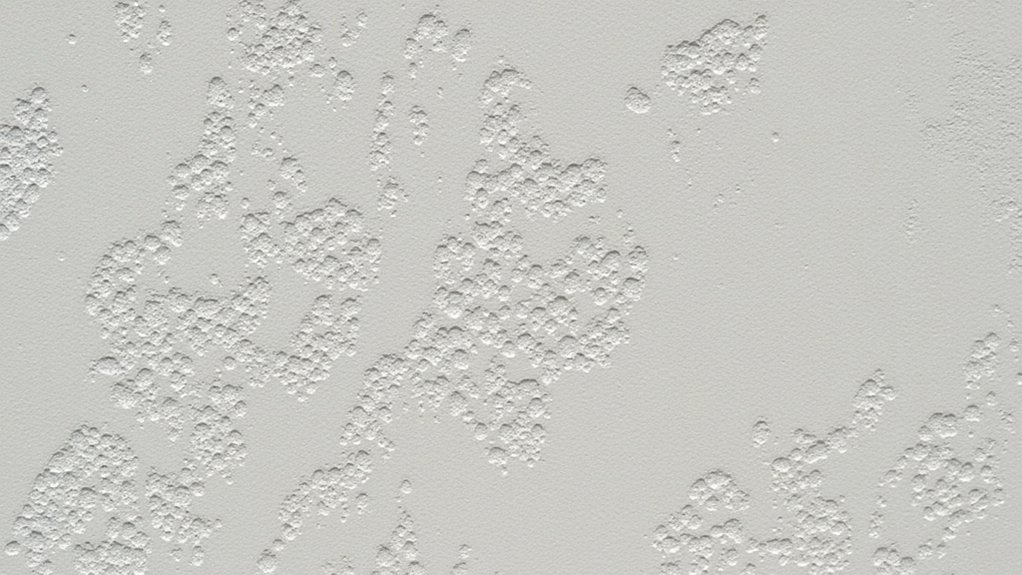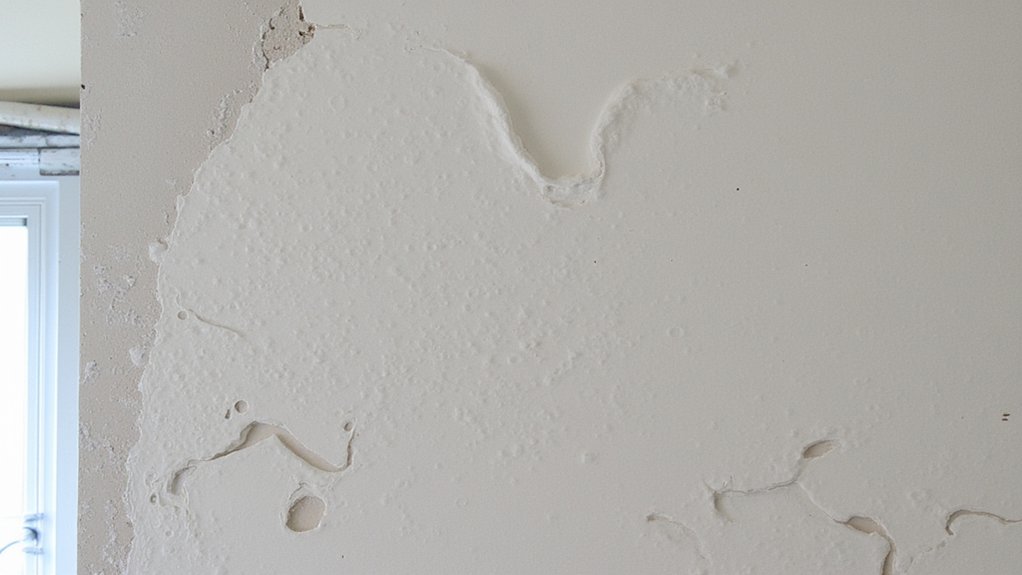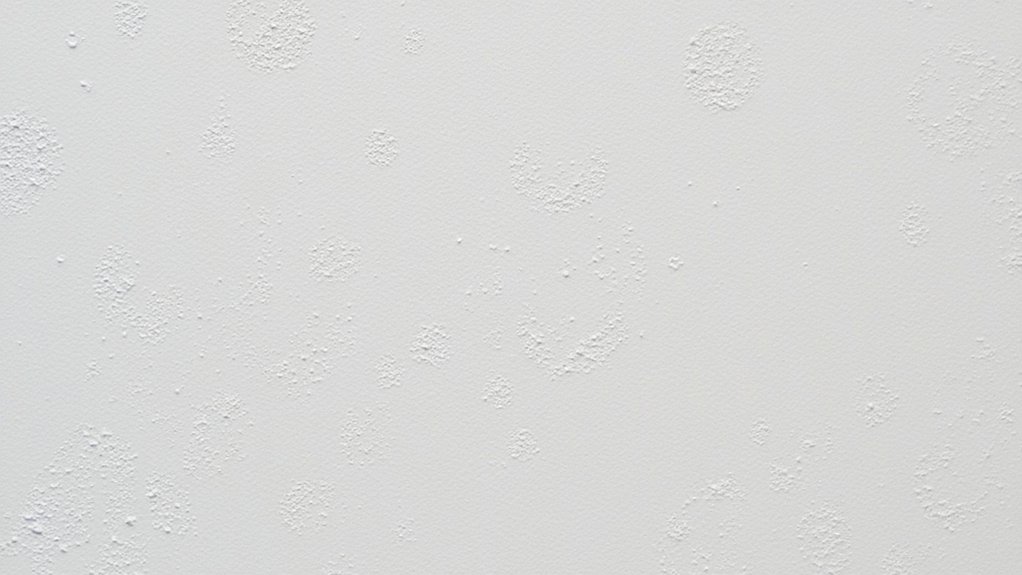You’ve likely encountered those frustrating bubbles appearing in your drywall mud after painting – a common problem that can ruin the smooth finish you’re aiming for. Professional contractor Mike Stevens explains, “Most bubbling occurs when moisture gets trapped between layers or there’s poor surface preparation.” While several factors contribute to this issue, understanding the root causes will help you achieve that flawless finish you want. Let’s explore the main culprits and proven solutions to prevent these pesky bubbles.
Common Causes of Drywall Mud Bubbling

When drywall mud bubbles appear on your painted walls, they’re typically caused by several common installation and environmental factors.
Key causes include:
- Applying mud over dirty or dusty surfaces that prevent proper adhesion
- Using wet joint compound over areas that haven’t fully dried
- Not properly mixing the mud before application
- Working in high humidity conditions above 50%
- Spreading the compound too thickly in single coats
“The most frequent culprit is rushing the drying process between coats,” says Tom Mitchell, certified drywall contractor. “You’ll want each layer to dry completely for 24 hours before adding the next.”
Additional factors that lead to bubbling:
- Air pockets trapped during application
- Incorrect mud consistency (too thin or thick)
- Using cold mud on warm walls
- Paint applied before mud fully cures
Signs and Symptoms of Mud Separation

Although drywall mud separation can be tricky to spot at first, you’ll notice telltale signs appearing on your walls within days of application.
Key indicators include:
- Circular bubbles ranging from 1/8 to 1/4 inch in diameter
- A wavy, rippled texture across the surface
- Small craters or pinholes in the dried compound
- Visible separation between paint and mud layers
“The first warning sign is often a slight discoloration where the mud meets the wall,” says contractor Mike Reynolds. You’ll also notice:
- Areas that feel soft when pressed
- Paint that peels away in sheets larger than 2 inches
- A chalky residue on your fingertips when touching the surface
- Uneven sheen in painted areas, especially under direct lighting
Preventing Bubbles During Application

Since proper preparation is critical for bubble-free results, you’ll need to follow specific steps before applying drywall mud to your walls.
Key Prevention Steps:
- Mix your compound thoroughly but don’t over-mix
- Keep mud temperature between 55-75°F
- Apply thin layers (1/8 inch maximum)
- Wait 24 hours between coats
Professional contractor Mike Stevens recommends: “Always clean your walls with a damp cloth and let them dry completely before mudding. This removes dust that can cause bubbles.”
Additional Tips:
- Use a 6-inch knife for first coat
- Apply steady pressure while smoothing
- Scrape off any air pockets immediately
- Don’t thin the mud more than 10% with water
“The key is consistent pressure and proper mixing,” notes drywall expert Sarah Chen. “Rush the process, and you’ll create problems.”
Moisture Control and Wall Preparation
Before applying any drywall mud, you’ll need to get your walls’ moisture levels under control through proper preparation techniques.
Follow these essential steps for proper moisture control:
- Use a moisture meter to guarantee wall readings are below 12%
- Run a dehumidifier for 24-48 hours in damp areas
- Check for and repair any water leaks or condensation issues
Wall preparation checklist:
- Clean surfaces with a damp cloth to remove dust
- Let walls dry completely (at least 24 hours)
- Sand any rough spots or previous patches
- Apply primer to bare drywall areas
“Proper moisture control is vital – most bubbling issues stem from excess humidity in the substrate,” notes Mark Thompson, certified drywall contractor. You’ll want to maintain room temperature between 60-80°F with humidity levels at 50% or lower during application.
Fixing Existing Bubble Problems
Once you’ve addressed moisture problems in your walls, it’s time to tackle those pesky bubbles that have already formed in your drywall mud.
Follow these steps to repair existing bubbles:
- Scrape away loose material with a 6-inch putty knife
- Sand the affected area with 120-grit sandpaper
- Wipe clean with a damp cloth and let dry completely (30 minutes)
- Apply new joint compound in thin layers (1/8 inch max)
“Multiple thin coats will always perform better than one thick application,” says Mark Roberts, certified drywall contractor. “Let each coat dry for 24 hours before applying the next.”
For stubborn bubbles:
- Cut out damaged sections with a utility knife
- Fill with setting-type compound
- Feather edges 6-8 inches beyond repair area
- Sand smooth when fully cured
Best Practices for Long-Term Results
While preventing drywall mud bubbles requires careful attention to technique, you’ll get consistently smooth results by following proven best practices during installation and maintenance.
Key long-term practices:
- Always prime bare drywall before applying joint compound
- Mix compound to pancake batter consistency
- Apply thin layers (1/8 inch max) and let each dry completely
- Sand between coats with 120-grit paper
- Maintain room temperature between 55-70°F during application
“The key is building up layers gradually while controlling moisture and temperature,” says contractor Mike Reynolds. “Don’t rush the process.”
For ongoing protection:
- Use moisture-resistant primer
- Install proper ventilation
- Keep humidity below 50%
- Address water leaks immediately
- Repaint every 5-7 years with quality paint


